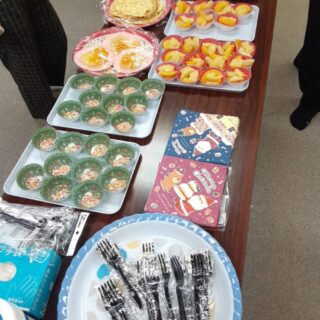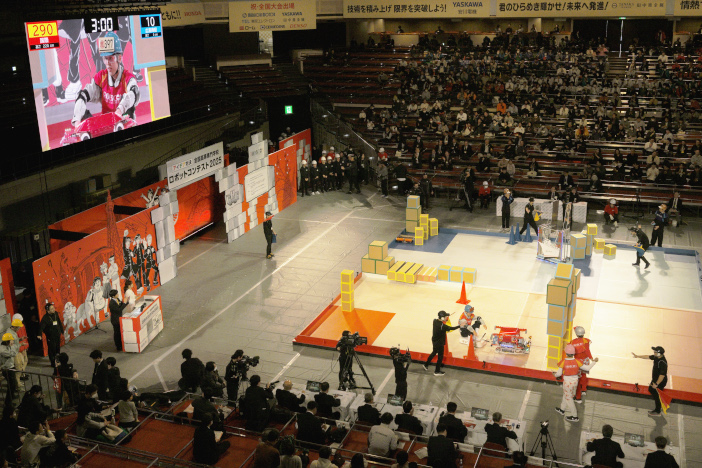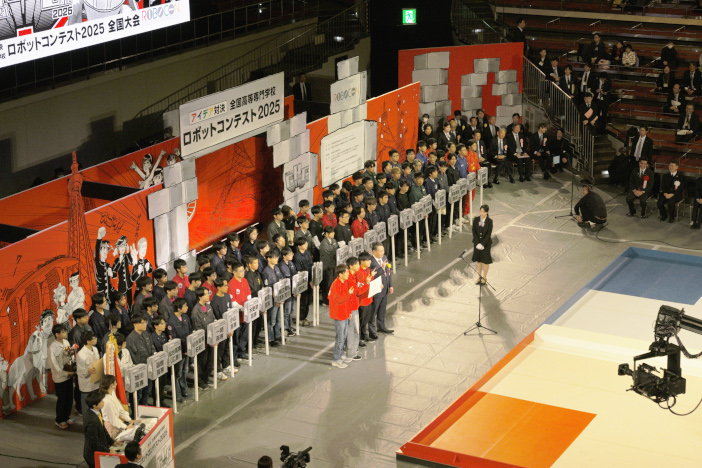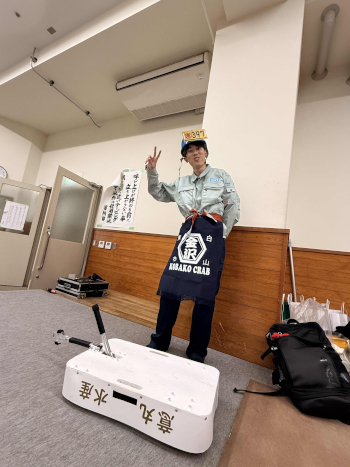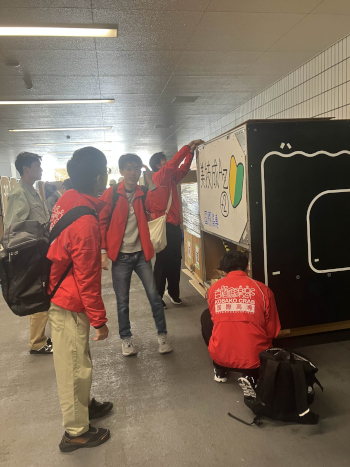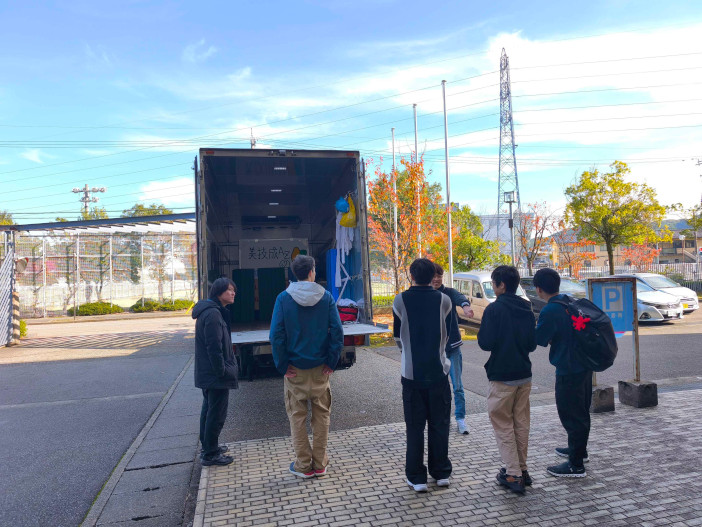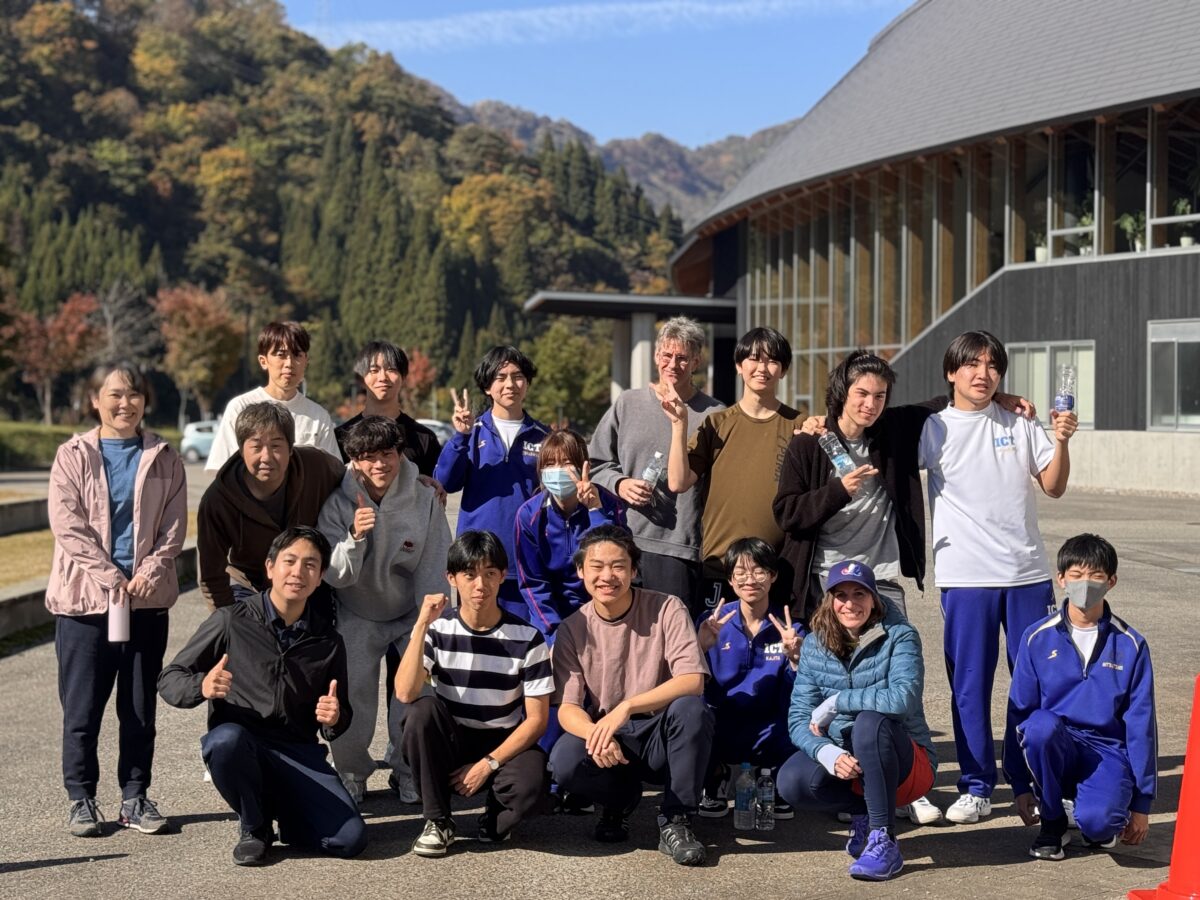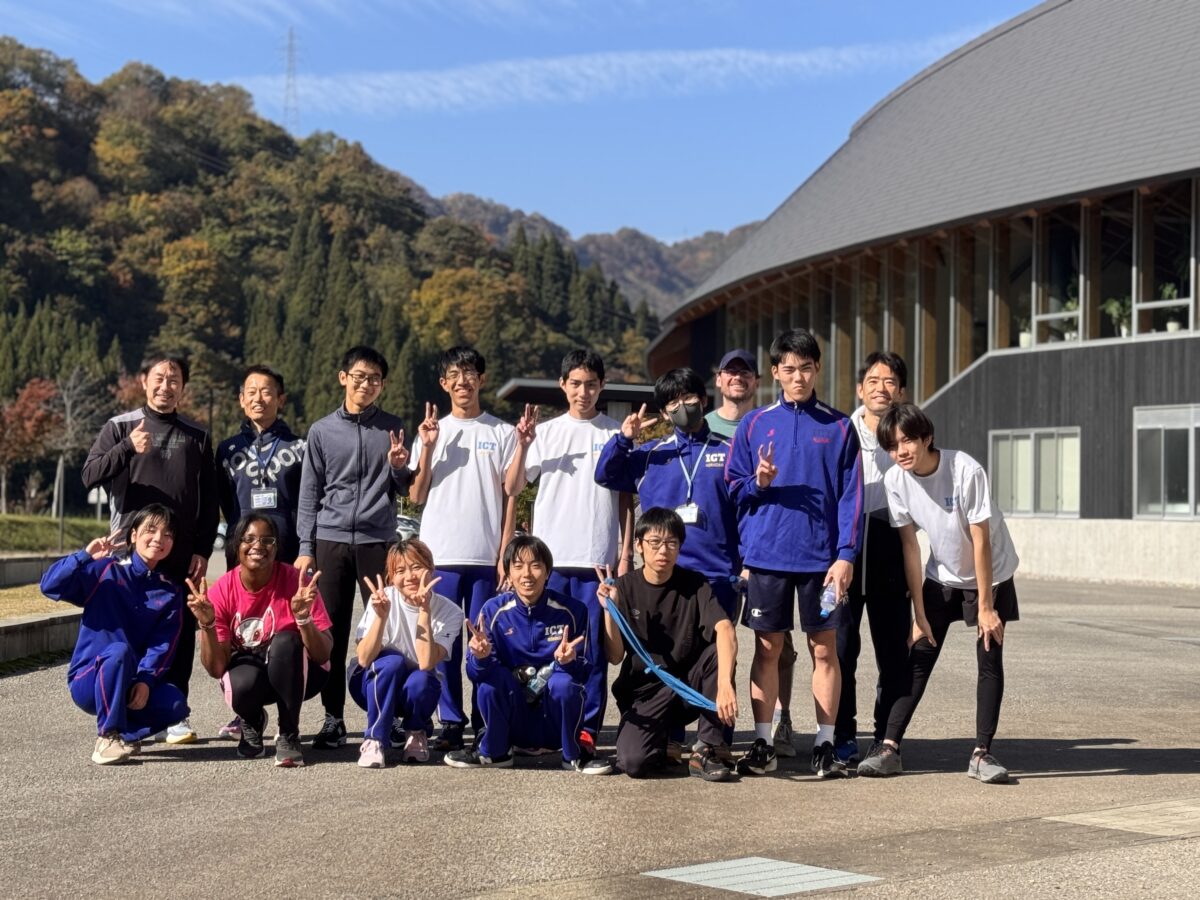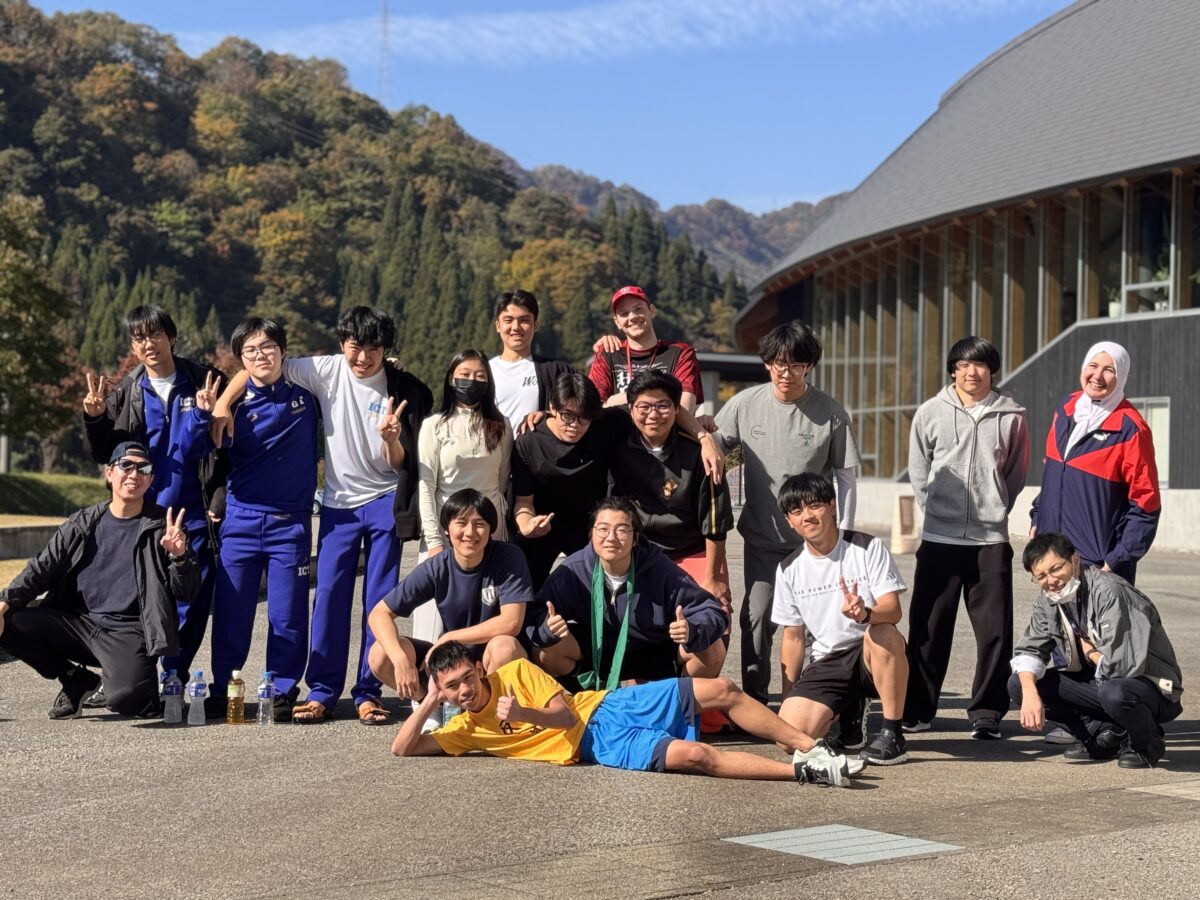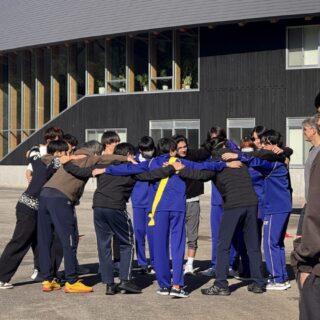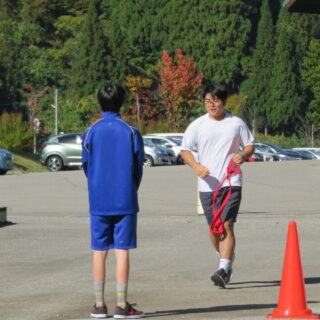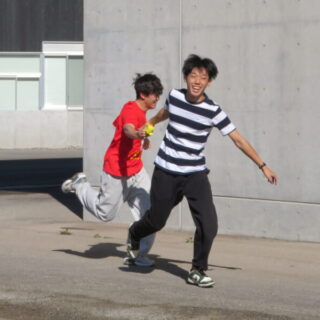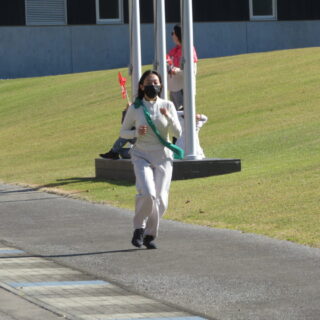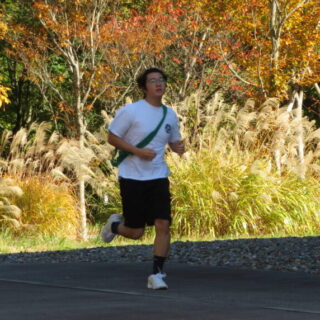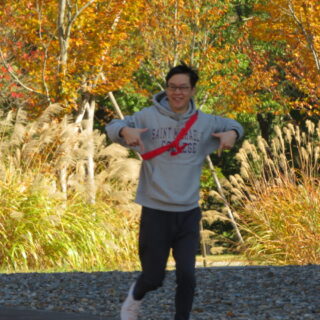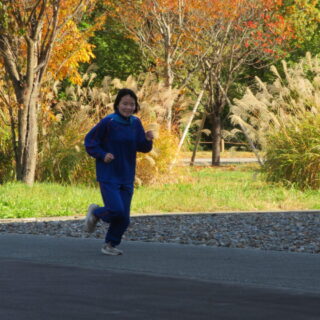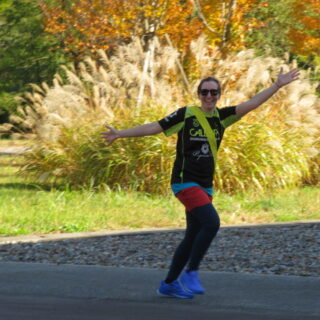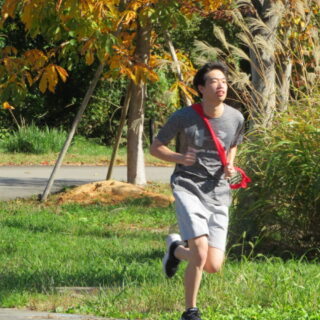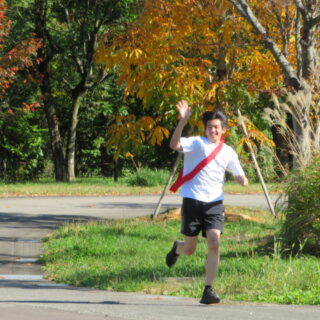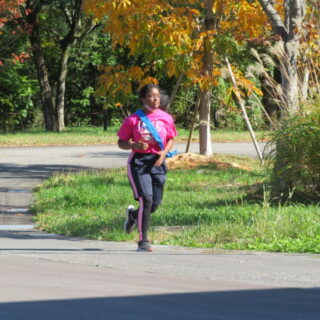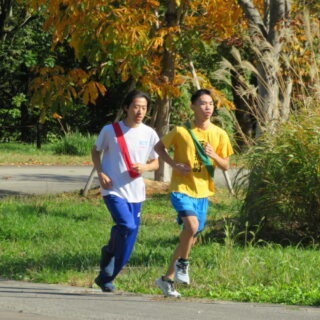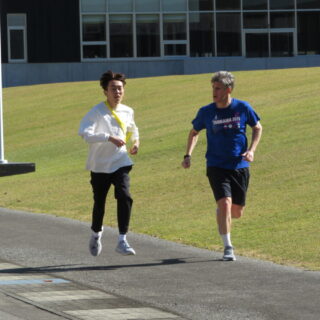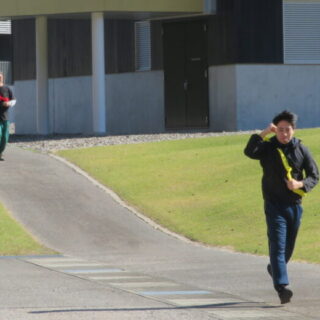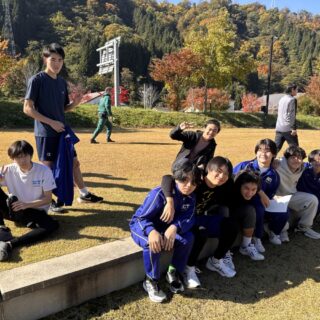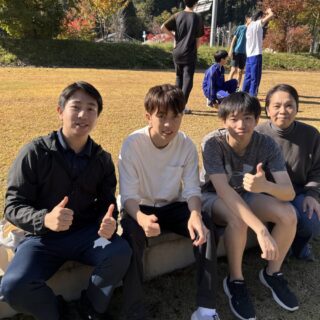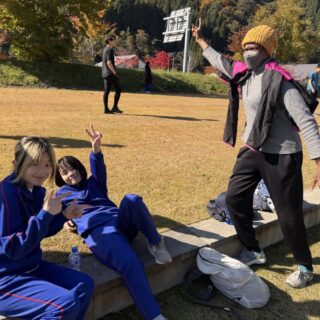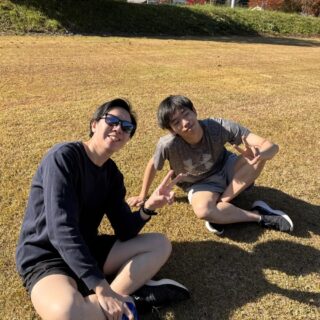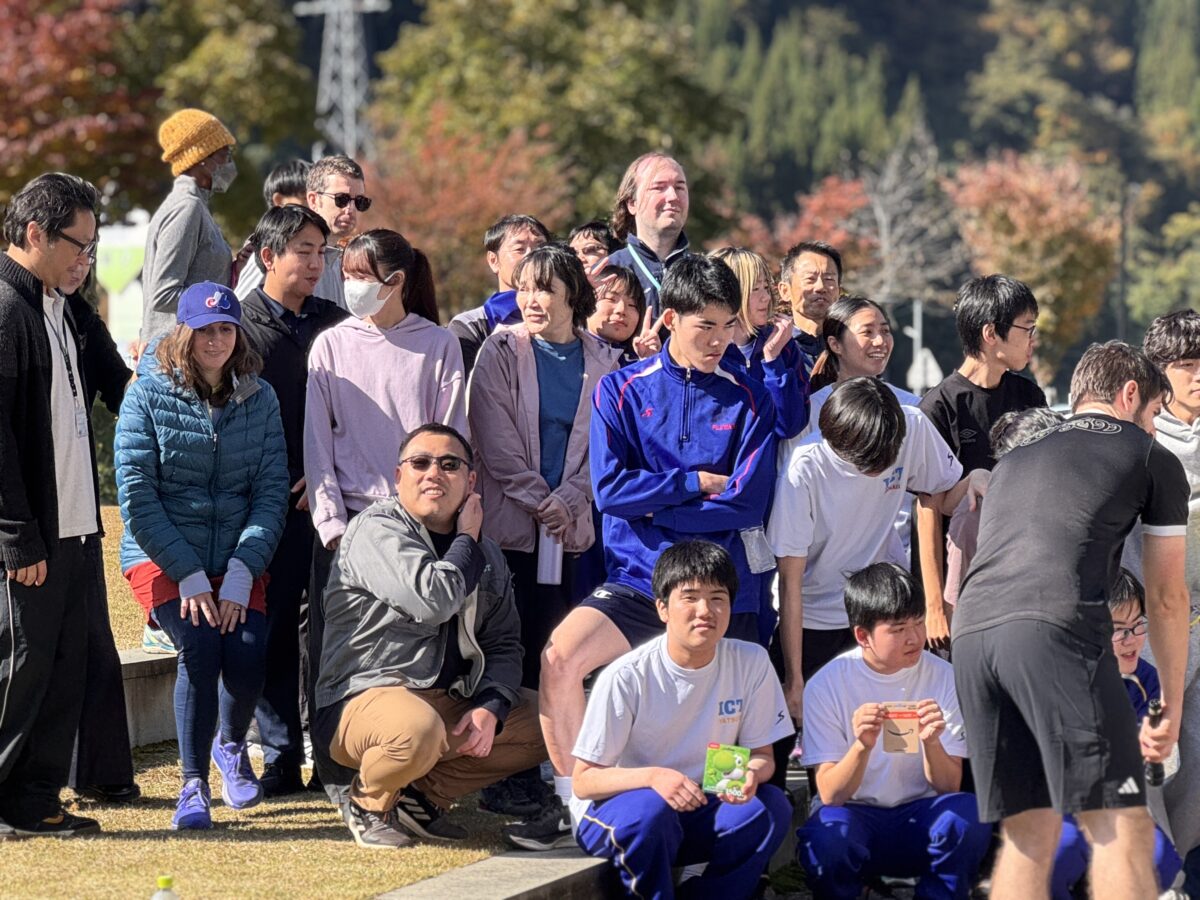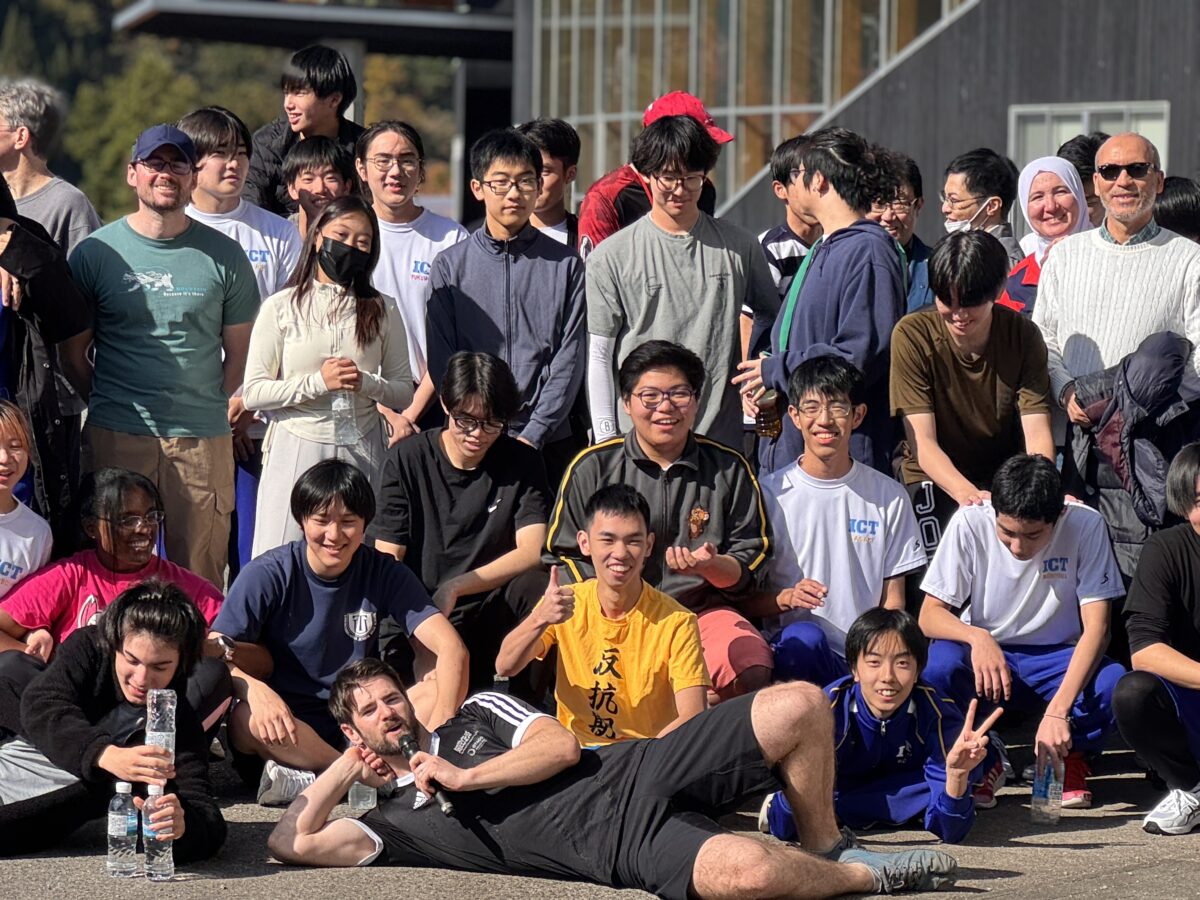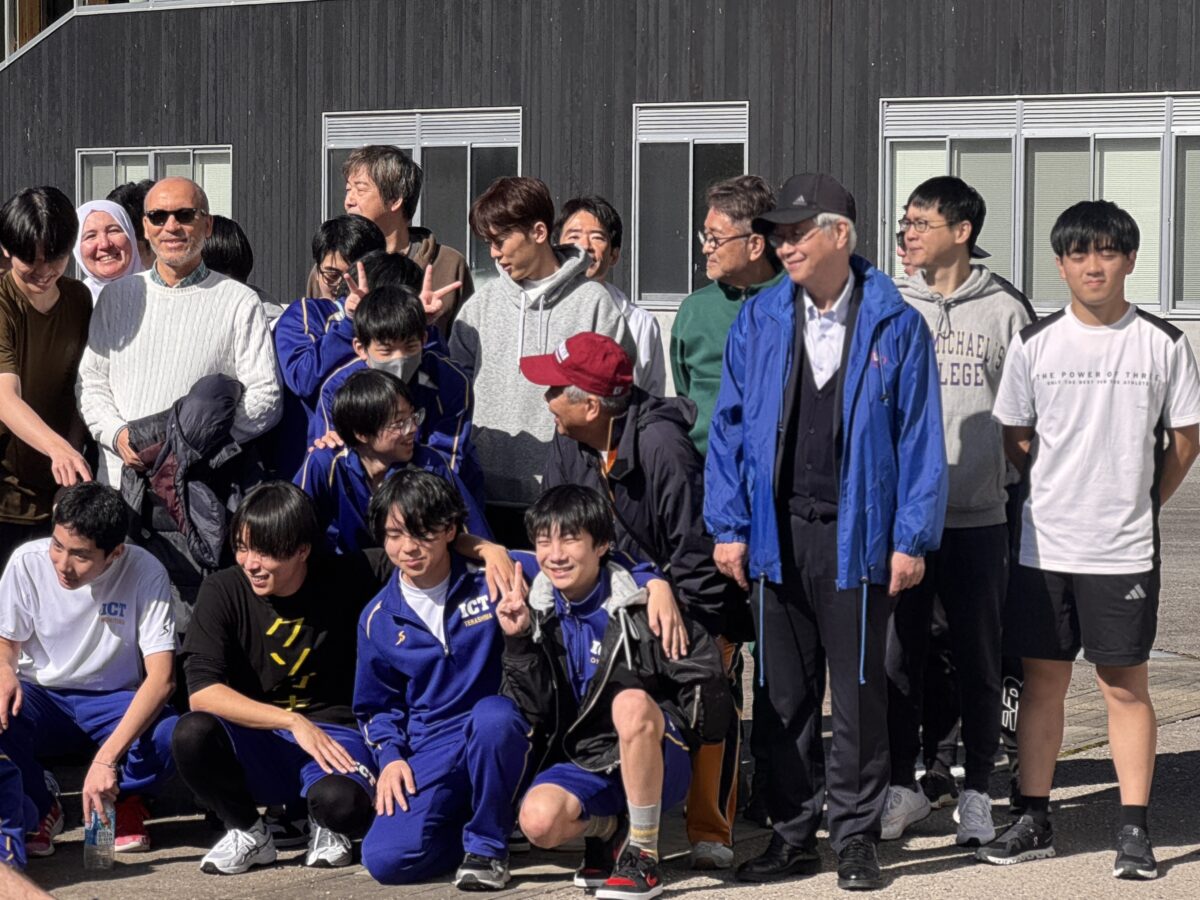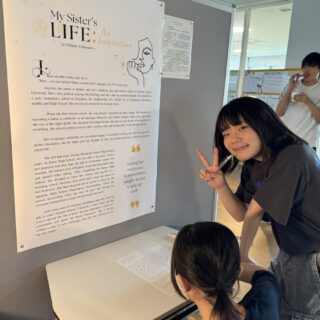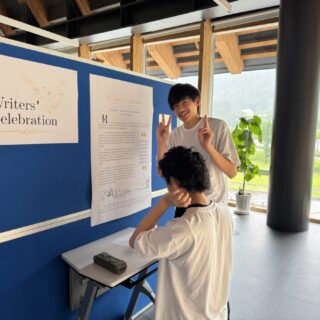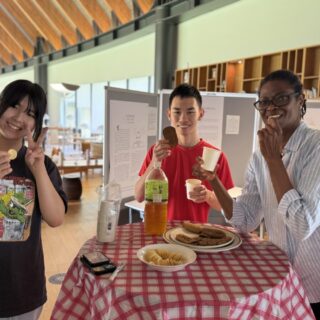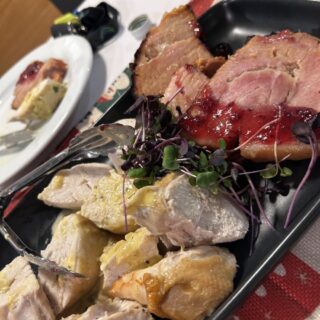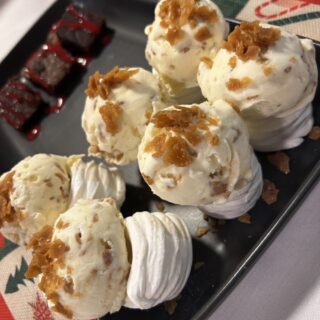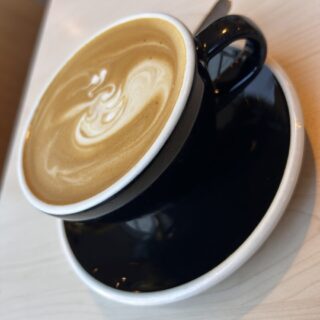FY 2025
2025年度の記事
 こんにちは。白山麓キャンパスで英語を教えているジェームス・テイラーです。
こんにちは。白山麓キャンパスで英語を教えているジェームス・テイラーです。
2025年12月3日(水)に尾口コミュニティセンターに行き、毎年恒例となっている地元住民のための「イングリッシュカフェ・クリスマスパーティー」を開きました。今回は、尾口地区、吉野谷地区、白峰地区から子供17人と大人5人が参加しました。パーティーが始まる約1時間前に、ちょうどよいタイミングで今シーズン初めての雪が降りました!
例年通り、まずはクリスマスツリーの飾り付けから始めました。高学年の小学生は低学年よりも少し遅く学校が終わるため、低学年の子どもたちは先にツリーの飾り付けを終わらせ、到着した高学年の友達に見せることができました。
その後、オリジナルの「アドベントカレンダー」を作るアクティビティをしました。アドベントカレンダーとは、24個(または25個)の小さな扉に1個ずつクリスマスらしいチョコレートなどのお菓子が入っているカレンダーで、12月1日からクリスマスイブ(またはクリスマス当日)まで毎日1つずつ扉をあけて中に入っているお菓子を楽しみます。
尾口コミュニティセンターのスタッフさんたちが、イベントのために特別に用意してくださったのは、手作りできるアドベントカレンダーでした。カレンダーの扉に自分の好きなお菓子を入れられるので、子供たちは楽しそうに「どれにしようかな」と悩んでいました。
アドベントカレンダーが完成し、手を洗った後は、パンケーキのデコレーションタイムです。尾口コミュニティセンターのスタッフさんたちがイギリスのレシピを使い、数時間かけてクレープのような薄いパンケーキを焼いてくれました。参加者は、準備された色々なトッピングから好きなものを選ぶことができ、完成したパンケーキは、見た目も味もとてもよかったです!
食事中、私が9月に白峰のイングリッシュカフェで子どもたちに読んだ時にとても人気だった絵本「Five Little Monkeys Jumping on the Bed」(アイリーン・クリステロウ著)を読みました。
最後に、クリスマスがテーマのビンゴをしました。子供も大人も全員プレゼントがもらえて大満足そうでした。そしてパーティーが終わる少し前、サンタさんが「メリークリスマス」を言いに来てくれました!
今年も、イングリッシュカフェのクリスマスパーティーは参加者全員が楽しめるイベントとなりました。これは主に、尾口コミュニティセンターのスタッフである山下さんや中田さんの努力と丁寧な準備のおかげです。心から感謝します。次回のイングリッシュカフェが今から楽しみです。
ジェームス・テイラー
 Hello everyone. I’m James Taylor, one of the English teachers at ICT’s Hakusanroku Campus.
Hello everyone. I’m James Taylor, one of the English teachers at ICT’s Hakusanroku Campus.
On Wednesday, December 3rd, 2025, I went to the Oguchi Community Centre to lead the annual English Café Christmas Party for local residents. This time, we had 17 children and 5 adults from the Yoshino, Oguchi, and Shiramine areas. With almost perfect timing, we had our first proper snowfall about an hour before the party began!
Just like every year, we started by decorating the Christmas tree. Since the older primary school children finished school a bit later than the younger ones, the younger children were able to finish decorating the tree in time for their older friends to see it when they arrived.
After that, everyone got the chance to make their own advent calendar. An advent calendar is a calendar with 24 or 25 doors, one for each day from the start of December to Christmas Eve or Christmas Day. Behind each door, there is usually some chocolate shaped like something Christmassy. The children at English Café were able to choose what small snacks or sweets they wanted to put behind the doors of their calendar. The advent calendars were make-it-yourself kits that the Community Centre staff bought especially for the event.
Once everyone had made their advent calendars and washed their hands, it was time to decorate some pancakes. The Community Centre staff used a British recipe and spent several hours making thin pancakes in preparation for the party, so guests were able to choose from a variety of toppings. They looked and tasted really good!
While they were eating, I read a story that was very popular when I read it to children at the Shiramine English Café in September: “Five Little Monkeys Jumping on the Bed” by Eileen Christelow.
Finally, we played Christmas-themed bingo, with prizes for everyone. Just before it was time to go home, Father Christmas came to say “merry Christmas” to everyone!
Once again, the English Café Christmas Party was an enjoyable event for children and adults, thanks mainly to the hard work and careful preparation of the Oguchi Community Centre staff, Mr. Yamashita and Ms. Nakada. I’m already looking forward to the next English Café.
James Taylor
 高専ロボコン指導教員の林道大です。「アイデア対決・全国高等専門学校ロボットコンテスト(高専ロボコン)」の全国大会が、2025年11月16日(日)に両国国技館で開催され、金沢キャンパスで活動している学生を中心としたAチームが出場しました。国際高専としての全国大会出場は、2022年以来の3年ぶりとなります。
高専ロボコン指導教員の林道大です。「アイデア対決・全国高等専門学校ロボットコンテスト(高専ロボコン)」の全国大会が、2025年11月16日(日)に両国国技館で開催され、金沢キャンパスで活動している学生を中心としたAチームが出場しました。国際高専としての全国大会出場は、2022年以来の3年ぶりとなります。
高専ロボコンは毎年テーマが異なるので、毎回新しいロボットを設計・製作し、4月中旬のテーマ発表から10月の初旬の地区大会の開催までにロボットを完成させなければなりません。今年のテーマは「Great High Gate」で、段ボール製のボックスを積み上げてゲートを作り、選手が乗った台車をロボットがひいて通過するというものです。ゲートの高さが高いほど高得点が得られます。東海北陸地区大会では、国際高専チーム「香箱倶楽部」は「技術賞」を獲得し、審査員推薦により全国大会進出を果たしました。
地区大会については、こちらの記事を参照ください。
地区大会以後、全国大会へ向けてロボットの改良を行いました。まず、移動速度の高速化です。移動するためのタイヤを駆動している機構の「歯車」や「スプロケット」を交換して、約1.7倍の速度で動き回れるようにしました。次に、ボックスを挟むつめの部分も「歯車」を交換したり、制御プログラムを調整したりして、こちらも約2倍の高速化が実現できました。ところが、ロボットの動きが早くなると操縦が難しくなり、操縦の担当学生は苦労していました。金沢キャンパス内だけではなく、夢考房(学生が自由にものづくり活動に取り組めるワークスペース)にもロボットを運んで、できるだけ実戦に近い形式での練習に取り組むことで、少しずつ操作に慣れていきました。
また、全国大会の会場である国技館では、ロボットの計量計測の検査場所、テストランや試合での各ゾーンの待機場所までロボットを運ぶ必要があります。また、エレベーターなどの設備も無いため、多くの人手が必要です。そこで、昨年のロボコンに参加した5年生の先輩2名に助っ人をお願いしました。先輩たちに快諾いただき、総勢6名のチームで全国大会に参加することができました。
大会では、第1回戦で広島商船高専の「厳島(いつくしま)」と対戦し、290対10で勝利しました。次の2回戦では、明石高専の「箱積明人(すたっくめいと)」に250対375で負けてしまいました。明石高専チームはその後も勝ち進み、準決勝で優勝チームの旭川高専に負けてしまいました。
試合が終わった後は、他チームのロボットを見学に行ったり、ピットで他の高専生との交流を深めたりしました。その間もピットではトーナメントに敗退したチームが、ピットの片付けやロボットの梱包等を進めていました。最後に、選手3名が閉会式に参加しました。閉会式では、優勝や準優勝が順に表彰されていき、デザイン賞の順番になったときには、まさか自分たちが受賞できると思っていなかったらしく、かなり驚いているようでした。受賞理由は、タコやカニなどの海の生き物をモチーフとしたロボットが多くあった中で、表現の方法が良く工夫されていたことでした。ロボットの装飾や選手の服装など、細かいところまでこだわって取り組んだのが良かったと思います。また、全国大会での受賞は、金沢高専時代に「百万石ファイター」が第6回大会(1993年)で技術賞を獲得して以来、32年ぶりだそうです。
全国大会では、選手の役割が地区大会とは少し異なっていました。そこで、改めてそれぞれのメンバーにひとこと、感想を聞いてみました。
■太田 晴喜さん

全国大会では、チームリーダーとロボットの操縦を担当しました。地区大会より動きが早くなったロボットの操縦は難しかったです。1試合目で左右を間違えて少し動きがぎこちなくなったところもありましたが、大きなミスなく得点することができて良かったです。
■白石 春翔さん
 全国大会では、ロボットの状況判断と動作指示を担当しました。ボックスのかげとなったり、ロボットの反対側になったりして、操縦者から見えない箇所の状況を見て判断し、ロボットがどのように動作したら良いかを操縦者に伝える役割です。地区大会では、ロボットの操縦をしていたので、その経験をもとに適切な状況判断と指示ができたと思います。
全国大会では、ロボットの状況判断と動作指示を担当しました。ボックスのかげとなったり、ロボットの反対側になったりして、操縦者から見えない箇所の状況を見て判断し、ロボットがどのように動作したら良いかを操縦者に伝える役割です。地区大会では、ロボットの操縦をしていたので、その経験をもとに適切な状況判断と指示ができたと思います。
■大石 意丸さん

全国大会でも引き続き台車に乗りました。オリジナル前掛けが追加されて、市場の人のコスプレがバージョンアップしています。ゲートを周回する動きも見せられて満足しています。他校の高専チームのロボットみたいにクルクル回らずに済んで良かったです。
■佐野 獅悠さん
 地区大会の地上波放送のエンディングで、仲間の勝利をフィールド外から祈っているシーンが使われた「お祈りしゆう」です。全国大会でも引き続きピットメンバーとして、ロボットのメインテナンスを担当しました。全国大会ではロボットの試運転や事前チェックをする場所や機会がほとんど無く、試合での一発勝負だったので、これまでにも増して集中して調整や点検を行いました。
地区大会の地上波放送のエンディングで、仲間の勝利をフィールド外から祈っているシーンが使われた「お祈りしゆう」です。全国大会でも引き続きピットメンバーとして、ロボットのメインテナンスを担当しました。全国大会ではロボットの試運転や事前チェックをする場所や機会がほとんど無く、試合での一発勝負だったので、これまでにも増して集中して調整や点検を行いました。
■橋谷 龍斗さん
全国大会には、ピット補助として参加しました。会場内でロボットや道具を運ぶ補助をしていました。昨年の地区大会に参加した経験を活かせたと思います。大会前後に、両国の町でみんなと一緒に楽しんだ食事も良い思い出になりました。
■セルゲレン・サンサルさん
全国大会には、ピット補助とセッティングタイムでのゲート設置の担当として参加しました。背が高いことを生かして、ゲート最上部のボックスを設置することができました。両国の「焼き鳥」がおいしかったです。
来年以降も継続して高専ロボコンに参加していく予定です。先輩の様子を見て、後輩たちが自分たちも参加したいと思ってくれれば良いと考えています。
 I am Michihiro Hayashi, a faculty advisor for the KOSEN Robocon (KOSEN Robot Contest) team. The National Competition of the KOSEN Robocon was held on Sunday, November 16th, 2025, at Ryogoku Kokugikan. Team A of ICT, mainly composed of students from Kanazawa Campus, participated in the event. This was ICT’s first appearance at the national competition in three years, since 2022.
I am Michihiro Hayashi, a faculty advisor for the KOSEN Robocon (KOSEN Robot Contest) team. The National Competition of the KOSEN Robocon was held on Sunday, November 16th, 2025, at Ryogoku Kokugikan. Team A of ICT, mainly composed of students from Kanazawa Campus, participated in the event. This was ICT’s first appearance at the national competition in three years, since 2022.
KOSEN Robocon features a different theme every year, requiring teams to design and build new robots from scratch between the theme announcement in mid-April and the regional competition in early October. This year’s theme was “Great High Gate,” where robots had to stack cardboard boxes to create a gate and pull a cart carrying a team member through it. The higher the gate, the higher the score. At the Tokai-Hokuriku regional competition, ICT’s team “Koubako Club” won the Technical Award and advanced to the national competition via the judges’ recommendation.
For more information about the regional competition, please see the article [NHK KOSEN Robocon 2025, Tokai-Hokuriku Regional Competition].
After the regional competition, we worked on improving the robot for the nationals. First, we increased its travel speed by replacing gears and sprockets in the drive mechanism, achieving about 1.7 times faster movement. We also upgraded the claw mechanism for gripping boxes and fine-tuned the control program, doubling its speed. However, the faster movement made operation more challenging, and the student in charge of driving the robot struggled at first. To overcome this, we practiced not only on the Kanazawa campus but also at YUMEKOBO — a makerspace for students to freely create and experiment— simulating real match conditions until the operator became more comfortable with the controls.
At Ryogoku Kokugikan, the venue for the national competition, robots had to be transported between inspection areas, test runs, and waiting zones without elevators, requiring significant manpower. We asked two 5th year students who participated last year to help. Thanks to their willingness, we were able to attend the national competition as a six-member team.
In the tournament, we faced Hiroshima KOSEN’s “Itsukushima” in the first round and won 290–10. In the second round, we lost to Akashi KOSEN’s “Stackmate” 250–375. The Akashi team advanced further but was defeated by the eventual champion from Asahikawa KOSEN in the semifinals.
Roles at the national competition differed slightly from the regional event, so we asked each member for their thoughts.
Comments from Team A Members:
[Haruki Ota]

As the team leader and the operator, I found controlling the faster robot challenging. In the first match, I made a slight mistake with left and right, but overall, I managed to control the robot without any major errors.
[Haruto Shiraishi]
 I was responsible for situational judgment and giving movement instructions. Using my experience as the operator in the regional tournament, I could make accurate decisions and guide the robot effectively.
I was responsible for situational judgment and giving movement instructions. Using my experience as the operator in the regional tournament, I could make accurate decisions and guide the robot effectively.
[Imaru Oishi]

I continued riding the cart at nationals. My costume was upgraded with an original apron, giving me a market vendor look. I was happy to show off smooth movements without spinning around like some other team’s robots.
[Shiyu Sano]
 Known as “Prayer Shiyu” from the regional broadcast ending scene, I handled robot maintenance in the pit. With almost no opportunity for test runs at nationals, every adjustment and check required intense focus.
Known as “Prayer Shiyu” from the regional broadcast ending scene, I handled robot maintenance in the pit. With almost no opportunity for test runs at nationals, every adjustment and check required intense focus.
[Ryuto Hashiya]
I assisted in transporting robots and tools inside the venue. My experience from last year’s regional competition was helpful. Sharing meals with teammates in Ryogoku was also a great memory.
[Sansar Sergelen]
I helped in the pit and set up gates during the preparation time. Thanks to my height, I could place the topmost box on the gate. The yakitori in Ryogoku was delicious!
We plan to continue participating in KOSEN Robocon in the coming years. I hope that seeing the seniors’ efforts will inspire younger students to join.
 白山麓キャンパスで保健・体育科目を担当しているフィリップ・ケザウです。2025年11月8日(土)、白山麓キャンパスでは「第2回チーム対抗駅伝大会」が行われました。レースの目的は、15名で構成された各チームがキャンパス周回コース(1周約670m)を合計25周走り切ることでした。チームは学年を超えて編成され、教員も参加しました。
白山麓キャンパスで保健・体育科目を担当しているフィリップ・ケザウです。2025年11月8日(土)、白山麓キャンパスでは「第2回チーム対抗駅伝大会」が行われました。レースの目的は、15名で構成された各チームがキャンパス周回コース(1周約670m)を合計25周走り切ることでした。チームは学年を超えて編成され、教員も参加しました。
目標は最速でゴールすることではなく、事前に予想したタイムに最も近いタイムで完走することでした。このルールは少し複雑に感じるかもしれません。通常の「最速チームが勝ち」という形式よりも確かに複雑です。しかし、この方式を選んだ理由はいくつかあります。急激な運動による怪我のリスクを減らすこと、速くない学生へのプレッシャーを軽減すること、そして教員が「チームを遅らせてしまう」という負担感なく参加できるようにするためです。
3チームが100分を予想タイムに設定し、1チームだけが86分と予想しました。当日は天候に恵まれ、雲ひとつない青空に紅葉の色が映える最高の日でした。涼しい風が吹き、まさに秋晴れの中での開催です。全員が整列し、学年を超えたチームに分かれた後、4年生の古元 柚希さんが素晴らしいスピーチをしてくれました。このイベントは学年間の交流の機会であること、そして1年生に対して「上級生は大きくて威圧感を感じるかもしれないけれど、怖がらずに話しかけてほしい」と励ましていました。
カウントダウンの後、チームは一斉にスタート!本来はペースを予測するゲームのはずが、当日の高揚感で全員が全力疾走。最初の8周は、わずか25分で走り終えてしまいました。まだ時間は十分あるのに、みんな全力です。そこで急遽、目標タイムを調整し、最終的には「80分に最も近いチーム」が勝者というルールに変更しました。
このイベントで最も印象的だったのは、学年間の雰囲気の良さです。応援の声が飛び交い、終始楽しい空気に包まれていました。私は運動が大好きですが、走ることに苦手意識を持つ学生も多いので、このように楽しく盛り上がる雰囲気はとても嬉しかったです。
その中、イアン・スティーブンソン先生は自分の順番以外でもずっと走り続けました。学生たちの間で、「イアン先生は何周走った?」という即興のクイズも始まり、彼の走り続ける姿は観客にとって刺激になっていました。レースは続き、タスキの受け渡しごとに歓声が上がり、誰もが主役になれる瞬間がありました。残念ながら、昨年同様に足首や呼吸がしづらい症状を訴えた参加者がいましたが、その人数は昨年より少なく、自覚症状のレベルですみました。最後の周回が終わり、結果は驚くほど接戦!時計やスマホで時間を確認できない中、全チームが目標の80分以内に10分差で収まりました。
結局、タイム目標方式はゴールの瞬間の盛り上がりには欠けましたが、怪我は減り、教員の参加も増え、学生にとっても競争のプレッシャーが少ない楽しい一日になりました。来年はどうなるでしょうか?スピードを重視する「競技形式」に再び魅力を感じるかもしれません。でも、今年は素晴らしい天気と素敵な仲間に恵まれ、キャンパスが分散している中で、このようなイベントが社会的なつながりを保つために重要だと改めて感じました。
フィリップ・ケザウ

This is Philip Cadzow, one of the Physical Education Teachers on ICT’s Hakusanroku Campus. On Saturday, November 8th, 2025, the second annual Ekiden (a team relay race) was held at Hakusanroku Campus. The goal of the race was for each team of 15 members to complete 25 laps around the campus (roughly 670 m per lap). The teams were composed of students from different year levels and teachers.
The objective was not to finish in the fastest time, but to be the team that completed the laps in a time closest to their estimate. This goal system may sound confusing and overly complicated; it is certainly more so than the usual “fastest team” approach. This design was chosen for several reasons: to reduce the risk of student injuries from sudden intense movement, to relieve pressure on those who were not as fast as others, and to allow more teachers to participate without feeling bad about slowing down a team.
Three of the teams chose 100 minutes as their estimated time, and only one team guessed that they would finish in 86 minutes. The day had perfect weather—clear blue skies with only a cooling wind. There were no clouds, only a blue sky contrasting with the changing colors of the leaves. With everyone lined up and mixed into their teams, Yuzuki Komoto—a 4th year student—gave a very nice speech about the event being an opportunity for different year levels to mix socially. He encouraged the 1st year students, saying that while the older students may seem big and intimidating, they should not feel afraid to talk to them.
After a countdown, the teams took off sprinting! What was meant to be a challenge to guess everyone’s pace soon changed with the energy of the day. I did not expect the excitement of running to be so powerful. The first eight laps were finished in only 25 minutes. Everybody was sprinting their fastest, even though they had plenty of time. Therefore, I had to make an emergency adjustment to the times, otherwise everyone would be far off their estimated time! Therefore, the competition was changed to which team managed to get the closest to 80 minutes total time.
I was most impressed with the atmosphere of the event; the feeling was very friendly between all year groups, and there was plenty of cheering and general enjoyment of the day. As much as I love and enjoy movement, sometimes that passion is not embodied in the many different types of students, especially when it comes to running. So, I was very happy that the atmosphere of the day was so joyous and filled with friendly rivalry.
A spontaneous guessing game of “How many laps has Ian-sensei run?” began to develop as well, his insatiable need to run being an inspiration to the watching crowd. The race continued and each changeover was cheered; each person had their time in the spotlight. Unfortunately, this also brought some of the same injuries as last year, with ankles and lungs feeling the pressure—but in fewer numbers than last year, and it was self-inflicted rather than prescribed.
The last laps were run, and the finishing times were very close! Considering that nobody had a watch or phone to keep track of the time, this was very impressive. All teams were within 10 minutes of the 80-minute goal.
In the end, having a time goal rather than a race was less satisfying to watch at the finish, but we had fewer injuries, more teacher participation, and the students had a slightly more relaxed and fun day rather than the pressure of competition. I don’t know what next year will bring—whether the allure of competition will call me back—but this year we had wonderful weather and good people. A lovely reminder that with a separated campus, events like these are important for social bonding.
Philip Cadzow
こんにちは、英語科目担当のポーリン・ベアードです。
今学期、2年生のリーディング・ライティングの授業では、学生たちが「Profile Essay」を書くために、自分にとってインスピレーションを与えてくれる人物にインタビューを行いました。家族について書いた学生も多く、メモを取りながら文章を仕上げていきました。書く過程そのものも価値あるものでしたが、最後に行われた「Writer’s Celebration」で最も重要な気づきがありました。
学生たちは、自分の作品を英語と日本語で掲示板に貼り、他の学生や教職員に披露しました。その様子を見て、私は「家族の物語を書くこと」が、学生たちが作家として、また思考する人としてのアイデンティティを育むための特別な窓(きっかけ)となることに気づきました。
また、Writer’s Celebrationを実施したことで、学生たちが英語で自然に物語を用いながら、自分の価値観を探求できることがわかりました。祖父母や両親について語る中で、共通するテーマ―「優しさ」「強靭さ」「リーダーシップ」「創造性」「感情的な強さ」―が見えてきました。ある学生は、祖父が雨の日に傘を差し出してくれたという小さな行為が、どれほど心に響いたかを語りました。これらの物語は単なる子どもの頃の思い出ではなく、世代を超えて受け継がれる教訓であり、学生自身の声で語られたものです。これを読むと、ライティングは文法や構造だけではなく、「何が大切で、なぜそれが大切なのか」を理解することでもあると改めて感じます。
発表中、学生たちは教員や他の学生たちからのコメントを誇らしげに読みました。自分の人生から生まれた文章だからこそ、彼らはその作品に強い愛着を持っていました。多くの学生が「自分は意味(価値)のある物語を語れる」という発見をし、他の学生たちも「私たちはこんなにも共通点を持っている」ということに気づきました。例えば、ある学生が母親の前向きな姿勢について書いた文章は、別の学生が父親の思いやりについて語った文章と響き合います。学生全員が互いの文章を目にする機会はそう多くありません。だからこそ、こうした共有の時間は、ライティングを皆で分かち合えるものにし、ワークシートのような問題解決学習では決して生まれない一体感を育てます。
教員にとっても、学生がどのように考え、感じ、意思決定をしているかを垣間見る貴重な機会となりました。学生が何を大切にしているのか―友情、努力、優しさ、家族―を知ることで、今後の授業づくりにも役立ちます。
Writer’s Celebrationは、単なる課題を「仲間と価値観を共有できる体験」に変えました。そのことは、学生が自分の物語を語る時、彼らは「自分は書き手である」と認識し、私たち教員も学生をより深く理解できるのです。
【Writer’s Celebration】
一般的に、執筆における成果と努力を称え、作家同士が互いに励まし合うイベントです。学生の文章を発表することで、モチベーションの維持、学びの定着、文章力向上や、仲間や学校コミュニティと喜びを共有することで達成感を高めることを目的として実施されます。
ポーリン・ベアード
Celebrating the Hearts Behind the Writing and the Community that Grows From It
Pauline Baird an English teacher at ICT.
This semester, students in the 2nd Year reading and writing class interviewed people who inspired them to write a Profile Essay. Several students wrote about family members, took field notes, and drafted profile essays. The writing process itself was valuable; however, the most meaningful insights emerged during the “Writer’s Celebration” at the end. As students shared their work on bulletin boards for the entire school to read (in English and in Japanese), I began to see how family-story writing opens a unique window into students’ developing identities as writers and thinkers.
The celebration showed that students can naturally use narrative, in English, to explore personal values. As the students shared stories about grandfathers, mothers, and fathers, common themes appeared—kindness, resilience, leadership, creativity, and emotional strength. One student described how a grandfather’s small act—an umbrella given on a rainy day—touched him deeply. These stories were more than childhood memories. They were lessons passed across generations, told in the students’ own voices. Reading them reminds us that writing is not only about grammar or structure. It is also about understanding what matters and why.
During the celebration, students read comments by teachers and others with pride. They had ownership of their writing because it came from their lives. Many discovered that they could tell a meaningful story, and their classmates discovered how much we all have in common. For example, a student’s reflection on her mother’s positive mindset might echo another student’s story about his father’s compassion. It is not often that all students get to see other students’ writing. Thus, these shared moments make writing public and build a sense of community in a school that no worksheet can create.
For teachers, the celebration offered a rare window into how students think, feel, and make decisions. We learn what our students value—friendship, hard work, kindness, and family—and this helps us shape future lessons. A writer’s celebration turned a simple assignment into a shared human experience. It reminds us that when students tell their stories, they learn to see themselves as writers, and we learn to see students a little more clearly, too.
[Writer’s Celebration]
Generally, it is an event that celebrates achievements and efforts in writing, where writers encourage one another. The purpose is to publish student-writing to maintain motivation, reinforce learning, improve writing skills, and enhance the sense of accomplishment by sharing joy with peers and the school community.
Pauline Baird
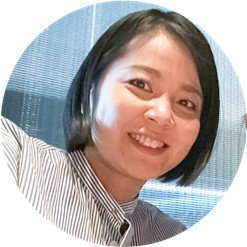 こんにちは。
こんにちは。
ニュージーランドのダニーデンにあるオタゴ・ポリテクニクにて職員研修留学をしている南戸です。普段は国際高等専門学校・金沢キャンパスで職員として勤務していますが、現在は夫と11歳の長女、5歳の長男とともに、10か月間の研修留学でニュージーランドに滞在しています。こちらでは、オタゴ・ポリテクニクの校舎でイベントマネジメントを専攻し、授業を受けながら、実務体験やインターンシップを通じて、現地の方々と一緒に働く貴重な経験をさせていただいています。
平日は授業の後、現地の小学校に通う子どもたちを迎えに行き、週末にはダニーデンの山や海、博物館、美術館、公園など、さまざまな場所を訪れています。また、イベントのボランティアなど地域のコミュニティにも積極的に参加し、現地の人々との交流を楽しみながら、家族で充実した時間を過ごしています。
今回は、ニュージーランドでの生活の中で出会った、現地ならではの食べ物をご紹介します。これから入学を控えている方や留学を予定している学生の皆さん、そしてそのご家族の方々に向けて、ニュージーランドの食文化を少しでも知っていただき、現地に行った際に「楽しそう!」「食べてみたい!」と思っていただけるような内容をお届けできればと思います。
まずはフェアリーブレッド(Fairy Bread・妖精のパン)です。これは子どもの誕生日会では定番のメニューで、食パンにマーガリンを塗り、その上にアイスクリーム用のカラフルなトッピング(スプリンクル)を散らした手作りのお菓子です。味は想像通り甘く、ザラザラとした食感が特徴ですが、子どもたちは大喜びでした。レシピはインターン先で子供たちのお誕生会を開く機会があり、その際に勤務先のダニーデン育ちのミカエラさんに教えていただきました。
そして、定番のスナックといえばこちら。ポテトチップスには「キウイオニオンディップ(Kiwi Onion Dip)」をつけて食べるのがニュージーランド流です。このディップは、NestléのReduced Cream(缶入り無糖クリーム)にオニオンスープの素(粉末)を混ぜるだけで簡単に作れます。特にソルト&ビネガー味のポテトチップスとの相性は抜群で、一度食べたら止まらない、永遠に食べ続けたくなるような中毒性のある美味しさです。
ニュージーランドでは、キャンディ全般を「ロリー(lolly)」と総称し、子どもから大人まで親しまれています。この写真に写っているのは、カラフルで細長いグミのようなロリー、そして「パイナップル・ランプス(Pineapple Lumps)」と呼ばれる、チョコレートでコーティングされたパイナップル味のソフトキャンディです。どちらもニュージーランドを代表するお菓子で、特にパイナップル・ランプスは“国民的おやつ”として長年愛されています。こちらも一度食べ出したらやめられないおいしさです。
こちらは「チーズロール」と呼ばれる、どのカフェでも見かける定番メニューで、比較的お手頃な価格で楽しめるのも魅力のひとつです。白いパンで作ったものもあります。ニュージーランド、特に南島で親しまれているソウルフードとして知られています。その正体はというと、薄切りの食パンにチーズフィリングを塗り、くるくると巻いてトーストしたもの。仕上げにたっぷりのバターを塗って頬張れば、思わず笑みがこぼれる“幸せの味”が広がります。
こちらはクリスマス料理の一例です。ニュージーランドでは真夏の8月に「ミッドウインター・クリスマス」と称して、クリスマスディナーを囲む家庭が多くあります。私もご縁があり、インターンシップ先のクリスマスディナーに参加させていただきました。食事はサラダやパンの前菜から始まり、メインにはポークやチキンのハムに、ローストしたお芋が添えられていました。このオレンジ色のお芋は「クマラ(Kumara)」と呼ばれ、ニュージーランドで広く親しまれている、さつまいもに似た野菜です。スーパーマーケットでもよく見かけ、焼き芋にすると絶品。我が家でも人気の食材でした。デザートには、ニュージーランド発祥とされる「パブロバ(Pavlova)」が登場。メレンゲをベースにした伝統的なスイーツで、外はサクサク、中はふんわりとした食感が特徴です。たっぷりの生クリームと季節のフルーツをのせて楽しむ、特別な日のデザートとして親しまれており、日本人にもなじみやすい味わいでした。
-
Roast ham and creamy chicken served with cranberry sauceローストハムとクリーミーチキンのクランベリーソース添え
-
Pavlova – a classic Christmas dessert in New Zealandパブロバというクリスマスに定番のデザート菓子
カフェに行くと、多くの人が飲んでいるのが「フラットホワイト(Flat White)」というコーヒーです。これは、エスプレッソにきめの細かいスチームミルクを加えたミルク入りコーヒーで、地元では定番の一杯として親しまれています。カフェラテよりもミルクの量が少なく、コーヒーの苦みや風味をしっかりと味わえるのが特徴かと思います。ニュージーランドのカフェを訪れた際には、ぜひ一度試してみてはいかがでしょうか。
ニュージーランドでの生活は、自然の豊かさや人々の温かさに触れる毎日です。食文化もその一部として、私たち家族にたくさんの驚きと楽しさを与えてくれています。この記事がこれから留学を考えている方やそのご家族の皆さんにとって、少しでも現地の暮らしが身近に感じられるきっかけになれば嬉しいです。そして、ニュージーランドの味を通して、皆さんの留学生活がより豊かで楽しいものになりますように願っています。
南戸 仁美
 Hello,
Hello,
My name is Hitomi, and I am currently on a one-year Sabbatical Training program at Otago Polytechnic in Dunedin, New Zealand. Usually, I work as an ICT staff member at the Kanazawa Campus. Now, I’m here in New Zealand with my husband, our 11-year-old daughter, and our 5-year-old son. At Otago Polytechnic, I’m studying Event Management, attending classes, and gaining practical experience through several projects and internships. These opportunities allow me to work alongside local staff and learn directly from the New Zealand work environment.
After classes on weekdays, I pick up my children from their local primary school. On weekends, our family enjoys exploring the natural beauty of Dunedin, its mountains, beaches, museums, arts, parks, and more. We also actively participate and volunteer in local community events, which have provided us with wonderful opportunities to connect with people and enrich our experience here.
In this report, I’d like to introduce some of the unique foods I’ve experienced during our stay. I hope this gives future students, their families, and anyone preparing to study abroad a glimpse into New Zealand’s food culture.
Let me start with “Fairy Bread”, a popular menu item at children’s birthday parties in New Zealand. It’s made by spreading margarine on slices of white bread and sprinkling colorful ice cream toppings (sprinkles) on top. As you can imagine, it’s sweet and crunchy, and the kids absolutely loved it. I learned the recipe from Mikayla, one of the supervisors at my internship, who’s a Dunedin local.
The next one is a classic Kiwi snack, potato chips with Kiwi Onion Dip. This dip is easy to make; just mix Nestlé’s reduced cream (a canned unsweetened cream) with powdered onion soup mix. It tastes very good, especially with salt and vinegar flavor chips, and is highly addictive. Once you start, it’s hard to stop! In New Zealand, all kinds of candy are affectionately called “Lollies”, and they’re loved by both kids and adults. In the photo, you can see colorful, chewy gummy lollies and Pineapple Lumps. These are soft pineapple-flavored candies coated in chocolate, and they’re so delicious you’ll find it hard to eat just one.
The “cheese roll” is a popular snack you can find in almost any café. It’s reasonably priced and tasty. Some are made with plain white bread. The cheese roll is found on the South Island of New Zealand, where it is loved as a kind of soul food. It’s just bread with cheese filling inside, rolled up, toasted, and topped with butter. One bite gives you a warm and happy feeling.
Here’s a Christmas meal in New Zealand. Many families celebrate Midwinter Christmas in August — the middle of winter in the Southern Hemisphere — by enjoying Christmas dinners. I was invited to a Christmas dinner hosted by my internship organization.
The dinner began with salads and bread, followed by a main course of ham, pork, and chicken served with roasted vegetables. The side was an orange-colored sweet potato called Kumara, a local favorite similar to the Japanese sweet potato. It’s widely available in supermarkets and absolutely delicious when roasted. My family enjoys eating kumara as well.
For dessert, we had “Pavlova”, a traditional New Zealand dessert said to have originated here. It’s a meringue with a crisp outer shell and soft, marshmallow-like center, topped with whipped cream and fresh seasonal fruit. It’s a festive treat that’s light and sweet. It has a familiar taste for Japanese visitors too.
-
Roast ham and creamy chicken served with cranberry sauceローストハムとクリーミーチキンのクランベリーソース添え
-
Pavlova – a classic Christmas dessert in New Zealandパブロバというクリスマスに定番のデザート菓子
Finally, no visit to a New Zealand café is complete without trying a Flat White. This espresso-based drink with finely steamed milk originated in New Zealand or Australia and is a local favorite. It has less milk than a latte, allowing the rich flavor of the coffee to shine through. If you find yourself in a Kiwi café, I highly recommend giving it a try.
Life in New Zealand has been filled with beautiful nature, warm people, and delicious discoveries. Exploring the local food culture has been one of the many joys of our stay, and I hope this journal helps future students and their families feel more connected to what awaits them here. May your own study abroad journey be just as rich, flavorful, and memorable.
Hitomi Nanto











